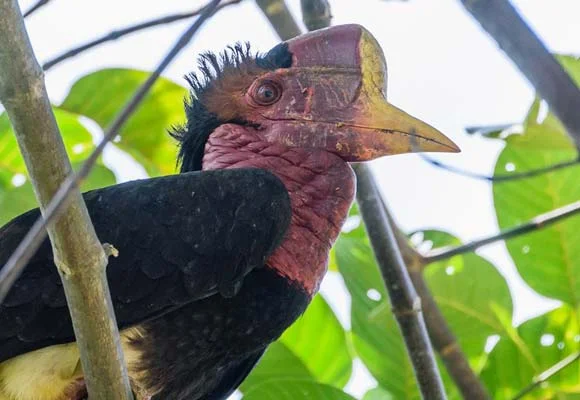Jakarta, Indonesia, 26th May 2016 — A new study published in the latest issue of Forktail, the journal of the Oriental Bird Club, has revealed that 13 bird species—including Indonesia’s national bird, the Javan Hawk-eagle—found in Sundaic Indonesia are at serious risk of extinction because of excessive over-harvesting.
The study, Trade-driven extinctions and near-extinctions of avian taxa in Sundaic Indonesia, also finds that an additional 14 bird subspecies are in danger of extinction. The driver behind this crisis is the enormous demand for birds for the domestic pet trade.
The keeping of birds as pets in Indonesia is an integral part of the national culture, yet the high levels of demand for some species have fuelled excessive hunting with the populations of many rapidly disappearing.
Besides the Javan Hawk-eagle, the other full species at risk include the Silvery Woodpigeon, Helmeted Hornbill, Yellow-crested Cockatoo, Scarlet-breasted Lorikeet, Javan Green Magpie, Black-winged Myna, Bali Myna, Straw-headed Bulbul, Javan White-eye, Rufous-fronted Laughingthrush, Sumatran Laughingthrush and Java Sparrow.
Although most of them are kept as pets, the Helmeted Hornbill is an exception: as TRAFFIC recently revealed, thousands are being illegally killed and traded for their unique solid bill casques, carved as a substitute for elephant ivory, to meet demand in China.
Another of them, the Javan Green Magpie, was recognized as a full species as recently as 2013—and simultaneously documented as in grave danger of extinction owing to trade pressure. In direct response, the Threatened Asian Songbird Alliance (TASA), operating as a formal body of the European Association of Zoos and Aquaria (EAZA), initiated a programme of captive breeding in a number of zoos, as assurance colonies, for security and propagation purposes.
Such conservation breeding is the last hope for some of the taxa affected. According to the study: “Regrettably five subspecies…are probably already extinct, at least in the wild, due primarily to trade.” They include one subspecies of a parrot (Scarlet-breasted Lorikeet), three subspecies of White-rumped Shama, an accomplished songster and one of the Hill Myna, popular because of its ability to mimic human voices.
“Whether its species or subspecies, the message is the same: excessive trade is wiping out Indonesia’s wild bird species at an alarming rate” said Dr Chris Shepherd, TRAFFIC’s Director for Southeast Asia, and a co-author of the study.
“Despite the alarming scale and consequences of the bird trade, governments and even conservation organizations often don't view this issue as a high priority. This hampers efforts to prevent further losses.”
The solutions to the bird trade crisis in Indonesia lie in a combination of better law enforcement, public awareness campaigns, in situ management, conservation breeding, conversion of trappers to wardens and field, market and genetic surveys, say the study’s authors.
Meanwhile as certain favoured species disappear because of trapping, others are targeted as “next-best” substitutes, while commercial breeders sometimes hybridise taxa for “better” effects, leading to further conservation complexities.
The study’s authors also consider whether commercial breeding could help alleviate the situation, but conclude that “while attractive in theory, [commercial breeding] presents difficulties that are probably insurmountable in practice.”



























